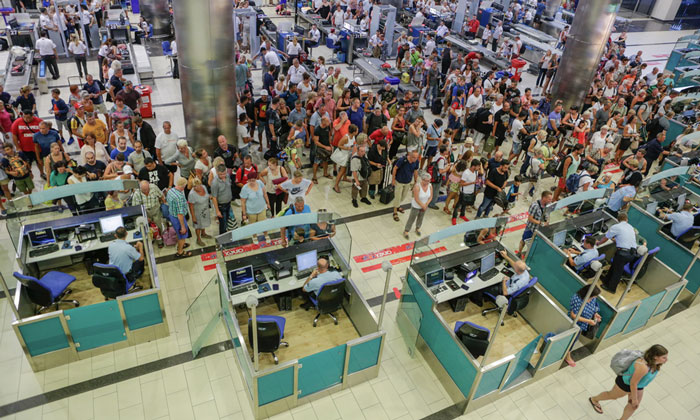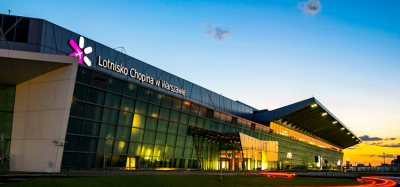Why the aviation sector cannot build itself out of the capacity crisis
- Like
- Digg
- Del
- Tumblr
- VKontakte
- Buffer
- Love This
- Odnoklassniki
- Meneame
- Blogger
- Amazon
- Yahoo Mail
- Gmail
- AOL
- Newsvine
- HackerNews
- Evernote
- MySpace
- Mail.ru
- Viadeo
- Line
- Comments
- Yummly
- SMS
- Viber
- Telegram
- Subscribe
- Skype
- Facebook Messenger
- Kakao
- LiveJournal
- Yammer
- Edgar
- Fintel
- Mix
- Instapaper
- Copy Link
Posted: 1 March 2018 | Simon Meyer | Managing Director of Aviation Solutions | Human Recognition Systems | No comments yet
In February, the head of the International Air Transport Association (IATA) issued a warning about the growing capacity crisis that faces the aviation industry. But is simply building more the best way forward? Simon Meyer of Human Recognition Systems tells us more.


CROWDED: It is estimated that global passenger numbers will double by 2036
The global aviation industry is facing a serious problem: capacity crisis. Improving capacity is a goal that is shared by nearly every airport and the International Air Transport Association (IATA) is aware of the troubles that lie ahead, recognising the urgent need to address the growing capacity issues that the industry faces. It is forecast that 7.8 billion people will use air travel by 2036, almost doubling the four billion passengers that travelled last year. The rising passenger demand is creating huge challenges for the industry – this was the focus at the Singapore Airshow Aviation Leadership Summit (SAALS) in early February.
In many cases, airports are dealing with old buildings and legacy systems that are struggling to cope with demand. The answer to the capacity crisis is not tarmac and terminals. What if there were other ways to expand the capacity of an airport, without expanding the airport’s footprint? Building new infrastructure is not always feasible or realistic, with rising costs and lack of space to build at many airports.
Governments and authorities, who in part can support new infrastructure builds (but at what speed?), should be supporting airports to grow from within to utilise the existing infrastructure to maximum effect. This includes investing to maximise new technologies and processes, such as biometrics and big data, which can offer huge efficiencies and opportunities for innovation.
Working smarter, not harder
This approach isn’t dissimilar from what the Director General of IATA, Mr Alexandre de Juniac, discussed in his keynote speech at SAALS. It’s not about building more, but about building better.
In our experience, most airports have additional capacity that they are not currently tapping in to. There are bottlenecks in airports and lack of passenger information is adding to the feeling that our airports are creaking under the pressure of the increasing popularity of air travel.
When airlines and airports operate as separate entities, there is inevitable duplication and reduced operational efficiency. For instance, poor management of passengers within the airport space can lead to delayed departures, having a huge knock on effect on capacity.
The aviation ecosystem can be compared to a relay race, where the overall performance (the passenger’s journey) is dependent upon each individual runner. For each player to operate efficiently, getting the passenger seamlessly from landside to airside requires a holistic view of the passenger.
It is critical that airports and airlines collaborate to improve capacity, particularly for many existing airports that simply do not have the footprint to build. By sharing real-time information between the relevant stakeholders, steps can be taken to improve efficiency and the airport can move from the ‘one-size-fits-all‘ approach to passenger management, to one that is personalised. For example, security staff can inform airline staff if booked passengers do not arrive, thus ensuring flights are not delayed by non-existent passengers. When people have the right information at the right time, improving operational performance becomes easier.
Looking how to leverage cutting-edge technologies, such as artificial intelligence (AI) and biometrics, is key for airports and airlines to provide a more efficient service and overcome the limits of infrastructure footprints.
Looking ahead
Ultimately, whilst we agree that the industry is facing a challenging period, it is not one that we are not capable of solving together. The situation is not going to get better without change, and failure to do so could result in a worsening picture – more delays, cancelled flights and increased costs and frustration for travellers.
The industry needs to look within to start addressing the problems and see the solutions that already exist to help the growth continue quickly whilst also improving customer service. It is only by maximising the use of existing infrastructure that the industry will have any chance of averting the looming capacity crunch.
Related topics
Airport construction and design, Airport development, Biometrics, Capacity, New technologies, Passenger volumes


















